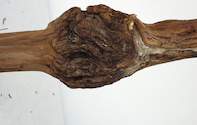Eutypa Dieback
Eutypa dieback is caused by the Eutypa lata fungus. The result is wood decay with the consequent death of the vines. The most characteristic symptom of eutypa dieback in a vineyard is short-node canes with small leaves.

The cordons of heavily infected vines can die and the grape bunches usually dry out. Cross sections of the cordons reveal the triangular dead wood.
The Eutypa fungus can penetrate the vines through the open pruning wounds. Eutypa dieback can be controlled by spraying the vines directly after pruning with a chemical fungicide or Trichoderma. If it starts to rain during pruning, the pruning process should be stopped because wet pruning wounds provide access for the fungus.
Pruning scissors should every day be disinfected before pruning with a suitable sterilizing agent. Remove all infected wood immediately and burn it to reduce inoculum levels in a vineyard.
Black Goo
Black Goo is one of several fungal diseases currently present in South Africa. Black goo, Petri disease or ‘young vine decline’ in a vineyard all indicate the same disease. The fungus occurs endophytic in the rootstock and the disease develops when plants are under stress, for example after the grafting process.
It is spread by pruning. There is currently no treatment for this disease, but the treatment of the grafting material and rootstocks with warm water before the graft process produces good results.
The disease can be prevented in various ways by establishing, among other things, the very best plant material. Young rootstocks and roots should not be shortened too much during planting time, and the planting holes should be deep enough for the roots to be spread out.
By Vinpro